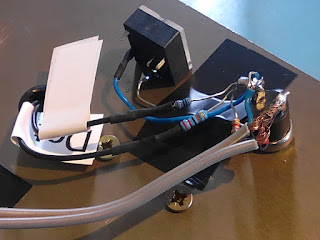- Break-in operation with variable delay
- Built-in iambic keyer with choice of 'A' or 'B' modes
- Variable keyer speed
- Straight key option.
The Hardware
 Interestingly, the Morse keys use the analogue input on the Arduino rather than the digital inputs. A network of resistors create different voltage levels depending on which contacts are closed, i.e. dot paddle, dash paddle, both paddles or straight key. Some UBITX builders have experienced erratic keyer operation due to the Arduino detecting the wrong voltages. This has been attributed to resistor tolerances etc., but I suspect that RF pickup may be a significant factor. For this reason I used screened cables between the Raduino board and the paddle/key connections (see photo). I wired a tune-up push-button in parallel with the straight key input. The wiring diagram is shown below.
Interestingly, the Morse keys use the analogue input on the Arduino rather than the digital inputs. A network of resistors create different voltage levels depending on which contacts are closed, i.e. dot paddle, dash paddle, both paddles or straight key. Some UBITX builders have experienced erratic keyer operation due to the Arduino detecting the wrong voltages. This has been attributed to resistor tolerances etc., but I suspect that RF pickup may be a significant factor. For this reason I used screened cables between the Raduino board and the paddle/key connections (see photo). I wired a tune-up push-button in parallel with the straight key input. The wiring diagram is shown below.Operating CW
The way that the UBITX works is a little quirky, so it is useful to start by looking at how conventional HF transceivers operate in CW mode.
If we have two 'normal' transceivers, one transmitting and one receiving, both on the same frequency, we would not hear any tone from the receiver. The receiver would 'zero beat' giving a 0Hz tone, clearly inaudible. Transceiver designers get around this by shifting the tuning by a few hundred Hertz when switched to receive. The dial will still show the transmit frequency, therefore the dials of both radios will be the same, assuming the calibration is correct.
With the UBITX, the VFO shifts by a few hundred Hertz (800Hz by default) when in transmit and the dial shows the receiver frequency. THIS MEANS THAT THE ACTUAL FREQUENCY BEING TRANSMITTED IS NOT THE FREQUENCY SHOWN ON THE DISPLAY. Therefore operators need to be careful when operating near the band edges that they are not transmitting outside of the amateur frequency allocation. When operating CW, the UBITX receiver can be set to either USB or LSB mode. In USB mode, the actual transmit frequency will be 800Hz higher than the frequency displayed. In LSB mode, the transmit frequency will be 800Hz lower than the display frequency.
When you operate the Morse key the radio will automatically switch from Rx to Tx mode. Note that the microphone will still be active, therefore it might be worth unplugging the microphone when operating CW. With version 4.3 of the firmware the straight key will not work unless it has been selected in the menu.
If we have two 'normal' transceivers, one transmitting and one receiving, both on the same frequency, we would not hear any tone from the receiver. The receiver would 'zero beat' giving a 0Hz tone, clearly inaudible. Transceiver designers get around this by shifting the tuning by a few hundred Hertz when switched to receive. The dial will still show the transmit frequency, therefore the dials of both radios will be the same, assuming the calibration is correct.
With the UBITX, the VFO shifts by a few hundred Hertz (800Hz by default) when in transmit and the dial shows the receiver frequency. THIS MEANS THAT THE ACTUAL FREQUENCY BEING TRANSMITTED IS NOT THE FREQUENCY SHOWN ON THE DISPLAY. Therefore operators need to be careful when operating near the band edges that they are not transmitting outside of the amateur frequency allocation. When operating CW, the UBITX receiver can be set to either USB or LSB mode. In USB mode, the actual transmit frequency will be 800Hz higher than the frequency displayed. In LSB mode, the transmit frequency will be 800Hz lower than the display frequency.
When you operate the Morse key the radio will automatically switch from Rx to Tx mode. Note that the microphone will still be active, therefore it might be worth unplugging the microphone when operating CW. With version 4.3 of the firmware the straight key will not work unless it has been selected in the menu.
While we are reviewing the operation of the transceiver on CW, it is just worth mentioning the sidetone. When the volume control is set to give moderate volume in receive mode, the sidetone on transmit will be very loud, requiring an adjustment of the volume. This may or may not be a problem. Because the output power on CW is quite low, one may be inclined to choose mainly strong stations to call. This would mean that the volume was already set low in receive mode and hence the sidetone would not be too loud. If necessary, it would not be too difficult to modify the PCB to reduce the sidetone level.
Disclaimer: This is my personal blog. Views expressed in my
posts are my own and not of my employer. The information provided comes with no
warranty. I cannot be held responsible for the content of external websites.
Any practical work you undertake is done at your own risk. Please make health
and safety your number one priority.



Comments
Post a Comment